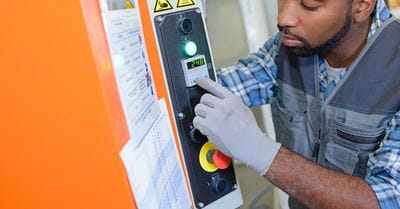Vertical Reciprocating Conveyors | Riverside

Raymond West supplies warehouse automation equipment such as VRC's.
We are among the largest suppliers of warehouse automation equipment in the state.
Call us today at (951) 384-2444.
What Is a Vertical Reciprocating Conveyor (VRC)?
A VRC is an efficient, relatively inexpensive, simple means to transport materials from one elevation to another. VRCs have applications in countless industries, including manufacturing plants, storage facilities, distribution centers, and other multi-story facilities. These versatile pieces of equipment can easily be incorporated into a structure’s basement, mezzanine, balcony or any upper floor levels.
VRC’s are made up of a shaft, a cage, and a mechanical or hydraulic system. Vertical material lifts can be installed just about anywhere on the interior or exterior of a structure. Gates and cages installed around VRC shafts ensure employee safety and well being.
What Are Some Advantages of VRCs?
Safety: Many operations rely on lift trucks for vertical movement of products. Although highly capable machines, lift trucks are primarily designed for the horizontal transport of goods. In the name of efficiency, workers may occasionally take their forklifts above their height limit or transport goods in excess of their truck’s capacity rating. When such infractions occur, the probability of a serious accident increase substantially.
For some vertical transport of goods between levels, VRCs offer a safe and effective alternative to forklifts. Specifically engineered and manufactured for each facility’s application needs, VRCs significantly reduce the chances of human error.
Additionally, VRCs are engineered to move larger loads more frequently. These more rapid throughput rates mean reduced labor hours and lower costs. For companies that have significant vertical lifting requirements, VRCs can enhance safety and decrease costs.
Customization: One major benefit to vertical reciprocating conveyors is the degree to which they can be tailored to specific applications. Because passenger elevators are designed to safely move people, regulations have been put into place that restrict the weight capacity, speed and size of these mechanisms. While such safeguards are appropriate for safely transporting people, they are prohibitive for high volume movement of goods in manufacturing plants, warehouses and distribution centers. VRCs can be readily customized because they are not subject to the same laws as passenger elevators.
Regulation: Vertical reciprocating conveyors are engineered to move materials only, while standard elevators are built to move both humans and materials. Because of this fundamental difference, VRCs are spared from the rigorous elevator regulations in many states.
On the contrary, VRCs are regulated by their own national code that is administered by the American Society of Mechanical Engineers (ASME), one of the first standards establishing organizations in the United States. More specifically, vertical reciprocating conveyors must comply with ASME’s Safety Standard for Conveyor and Related Equipment (ASME B20.1-2018). This standard defines the requirements for the fabrication, assembly, operating procedure and maintenance of conveyor systems.
Raymond West Is A Full Service Supplier of Vertical Reciprocating Conveyors
If you’re in the market for a VRC, want questions answered or require engineering assistance, Raymond West can help. Our conveyor system experts can help design, procure, install and maintain a system that’s suitable for your operation. Get in touch with us today!
Raymond West's Riverside service area includes Redlands, Colton, Rialto, Bloomington, Moreno Valley, Hemet, Perris, Lake Elsinore, Menifee, Coachella Valley and all surrounding areas.
Raymond West | Riverside Material Handling Equipment Supplier
Riverside, CA
(951) 384-2444

